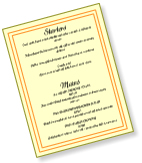So far we have considered the impact of communication difficulties on Thomasz; now let’s consider how they have affected Catriona …
It is clear that Thomasz was not aware of the impact his communication difficulties were having on Catriona. It will be helpful for them to explore their different feelings further. Strong relationships and an ability to work to address challenges are key factors for living successfully with these difficulties.
It is really important to acknowledge the huge impact that the sudden onset of a communication difficulty can have on all family members, who will commonly undergo emotional, relationship, social and financial disruption. These need to be recognised by the health and care team, who should then make sure the appropriate support is .
The social model of disability states that disability doesn’t stem from the person’s impairment but failure of the social/physical environment to take account of the person’s needs. Communication difficulties are often not widely recognised by others as a disability. They are often more hidden than, for example, a physical weakness or subtle in their presentation. As we can see with Thomasz’ challenges at work, in the restaurant and bridge club he experienced many barriers.
Let’s now review the 3 everyday situations which have been challenging for Thomasz because of his communication difficulties. Look at the table below and notice the challenges Thomasz faced in the HR meeting and eating out and the impact these had on him. Then, note how different his experience was at the bridge club when the environment was modified and communication strategies were put in place to enable him to participate.
| Situation |
Environment |
Impact on Thomasz: functional, psychological |
| HR meeting

|
Thomasz’ employers had a lack of understanding on how his communication difficulties would impact on his job |
Could not return to work at present
Loss of role/status/earnings |
| Eating out

|
Non-aphasia friendly menu
Waiter assumed Thomasz was drunkNot enough time given to Thomasz to choose food options |
Thomasz ate incorrect meal
Thomasz did not enjoy meal experience
Thomasz felt embarrassed and frustrated
Thomasz felt excluded |
| Socialising

|
Recognition of Thomasz’ communication difficulties
Positive environmental changes: discussed worries with Freddie
Agreed strategies with Freddie and the wider group to improve bridge playing, given his communication difficulties |
Improved social participation
Alleviated worries
Increased self esteem
Reduced social isolation |
It is important to recognise that, with appropriate information and education to improve public perception, these barriers can be overcome. There is still some way to go in changing the attitudes and educating the wider public on how they perceive communication difficulties. Even making small changes can make a big difference to the success of a situation for someone with a communication difficulty.
Due to the extent of his communication difficulties Thomasz struggles to communicate at the golf club and is largely unable to participate. Their is an event coming up at the golf club and Thomasz needs to make the ‘prize giving’ speech. Thomasz has indicated that he would like to be able to speak at the event but he feels self conscious. It will be noisy with lots of conversations going on at the same time. He wants to practice ahead of the day with SLT. Working with the SLT, utilising prompts and tools Thomasz is reassured that the speech does not need to be perfect. The value of participating will help build his confidence.
A fellow club member remembers seeing a poster for the Chest Heart & Stroke Scotland Advice Line and calls them. The Advice Line provides information on a local outreach service. This service provides volunteers who act as conversation partners supporting individuals to participate more fully in activities. The volunteer visits Thomasz at home to find out what difficulties he is having at the golf club.
Thomasz attends the golf club event the following week with his conversation partner.
| Thomasz’ worries |
Agreed adaptations |
Not being able to keep up with conversations |
Thomasz and the group agree he will indicate when he has something to say. |
Getting mixed up in club meetings and struggles to complete his scorecard when playing |
Thomasz and the group agree how to deal with potential mistakes |
Not playing as well as he used to and letting his teammates down |
Freddy practises with Thomasz |
They all agree that they will take it a step at a time and be honest about how it is working. Thomasz is reassured and when he returns to the club he realises that, although it might take a while, he is beginning to feel more like himself. Even small adaptations can make a huge impact by allowing a situation to become more accessible to people with a variety of impairments.
Thmasz friend Freddy offers to drive him home from the restaurant. On the way home in the car Freddy starts telling Thomasz about what’s been happening …
Freddy is talking too quickly and giving Thomasz too much information at one time. Thomasz feels overwhelmed by all this information and struggles to make sense of what Freddy is saying.
At his next speech and language therapy session Thomasz tells his therapist about the difficulties he experienced at the restaurant. Together they come up with some ways to make the situation easier in the future:

Following the meeting with HR Thomasz decides not to return to work at this point. To try and lift his spirits Catriona organises for Thomasz to go out out to dinner with some friends.

At the restaurant the waiter brings them over the menu and Thomasz is very keen to make his choice independently. Click here to view the menu: Italian restaurant menu [PDF, 117KB]
When Thomasz opens the menu he realises that it is very detailed and written in Italian and English. He finds it very difficult to read the menu but doesn’t want the others see he is struggling. The waiter approaches the table to take their order. Thomasz feels under pressure, so when the waiter suggests pork Thomasz agrees. Catriona looks baffled as she knows he doesn’t like pork and that his favourite food is fish.
When the meal arrives, Thomasz is frustrated and states he won’t go out for a meal again. He goes to the toilet and overhears the waiter saying ‘The man at table 6 couldn’t decide what he wanted and was slurring his speech – he must be drunk.’
Thomasz goes along to the Human Resources department to discuss the option of returning to work. In preparation for the meeting the Human Resources assistant has prepared a list of tasks that were involved in the job Thomasz had been doing before his stroke.
(For a reminder on Thomasz’ current speech and language issues see the Additional Information box below)
Thomasz found the meeting frustrating as he realised that he was going to be unable to fulfil his role as he did previously. It was difficult for him to communicate with the HR assistant and she struggled to understand him.
The types of communication difficulties Thomasz has will potentially impact on all areas of his work, even those which would have been relatively basic for him prior to his stroke. It can be surprising how much language is a part of so many everyday tasks.
For more information on vocational rehab see STARs AM 10: Resuming daily activities after stroke.

Thomasz sustained his stroke five months ago. He has received a letter from his employers asking him to attend for a return to work discussion.
Thomasz’ current speech and language issues are:
| Speech and language issue |
Description |
| Expression |
Can produce short phrases only, with sound errors and word finding difficulties, mild articulatory imprecision (unclear speech) due to his dysarthria. This worsens with fatigue. |
| Auditory comprehension |
Can understand short sentences but has difficulty with more complex language. Needs time to process information. |
| Reading comprehension |
Can read two to three words at a time in simple language. |
| Writing |
Can write single words e.g. simple nouns and verbs. |
| Numeracy |
Can recognise numbers but struggles with calculation. |
Thomasz has had a left hemisphere stroke resulting in two different types of communication difficulties – aphasia and dysarthria.
Aphasia is a disorder of language affecting understanding, expression, reading and writing. Dysarthria is a disorder of speech production caused by changes to muscle function. This can cause slurred, quiet or imprecise speech. In the UK approx a third of people who have a stroke will experience aphasia and approx a third will experience persisting dysarthria.
Communication difficulties post stroke can have a lifelong impact on how someone participates in everyday activities. In the next section, we will explore the impact of aphasia on 3 aspects of Tomasz’s life:
- Return to work
- Socialising with friends
- Family life
Click on the each of the links below to learn more about this:




